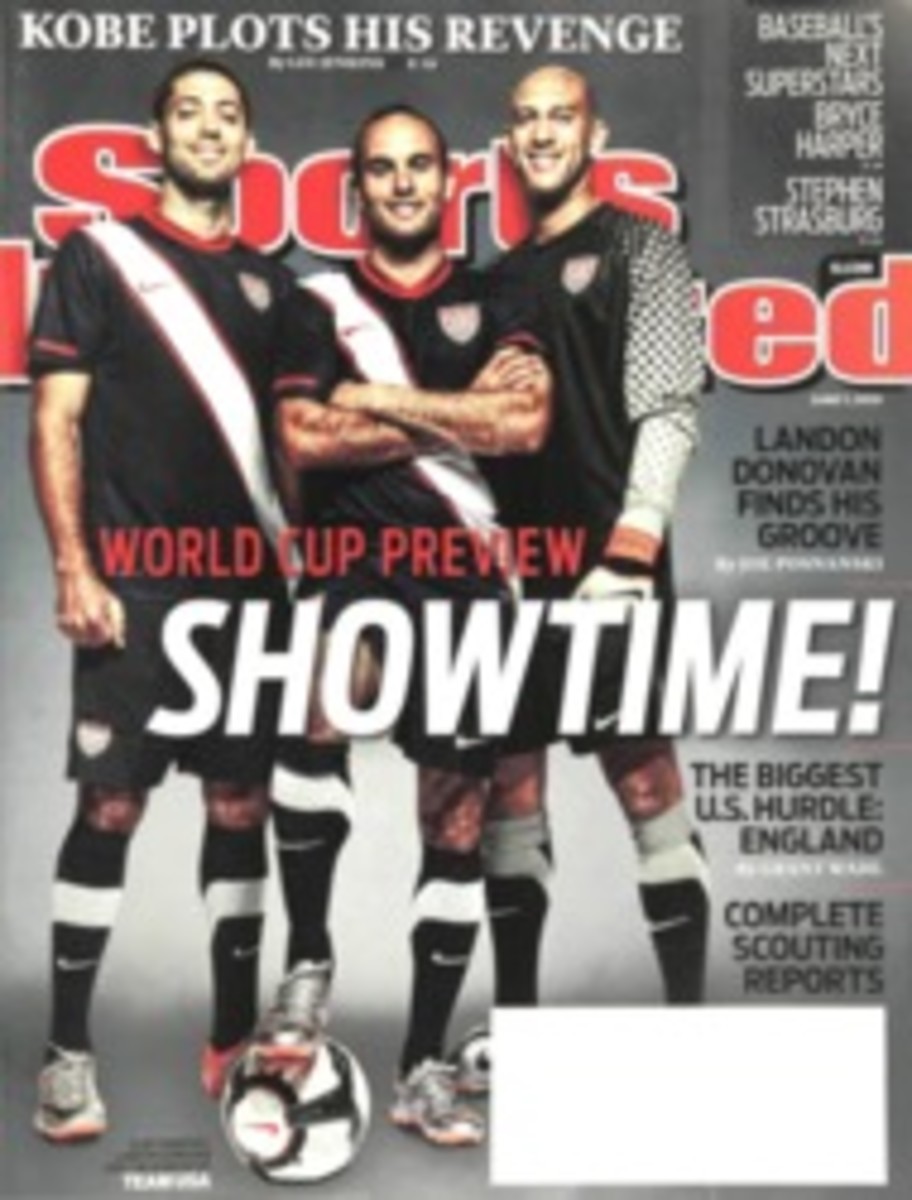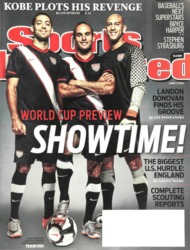
Prep School
With its big-time feel and code of conduct, the American Junior Golf Association is developing young golfers for the college game—and beyond
It's the night before the Thunderbird International Junior, the big kahuna of the American Junior Golf Association season, and Jordan Spieth is in a banquet hall, hopping up and down on his right leg. "Simon says, 'Pat your head,'" shouts one of the tournament emcees, and the 16-year-old Spieth and 77 other junior golfers are hopping and patting, hopping and patting, the boys decked out in orange shirts, the girls in pink. Through the banquet hall's picture windows, the sunset view of the Raptor course at Grayhawk Golf Club in Scottsdale, Ariz., is breathtaking, even if it is partly obscured by air hockey, Ping-Pong and Foosball tables. The boys' defending champion, Daniel Lee, who went 18 under par in the 54-hole event last year, has selected a scrumptious menu this evening: Caesar salad with tortilla chips, two slabs of steak, green beans, a twice-baked potato and chocolate cake with strawberries. The champions dinner at the Masters has nothing on these kids. "Hop on your left leg!" says the emcee, and Jordan switches feet, eliminating him and all of the guys at his table, a group of kids in the midst of raging hormones, high school exams and, in Spieth's case, a whirlwind that a week ago included a star turn at the PGA Tour's Byron Nelson Championship, in which he finished 16th, received boisterous ovations before hometown crowds and had his baby face beamed around the globe. "Thursday at the Nelson, my first tee shot was by far the most nervous I'd ever been doing anything in my life," Spieth says. "Second would be asking someone to prom."
After the Nelson, Spieth squeezed in four days of classes at Dallas Jesuit High, where he is a junior, before flying without his parents to Phoenix to compete in the Thunderbird, which is played on a course that has hosted Tour events. Friends and strangers kept asking Spieth if he would feel a letdown after the big crowds and the caddie and the final-round pairing with U.S. Ryder Cup captain Corey Pavin at the Nelson. Spieth said he wouldn't. His reason was the Thunderbird's deep field—players such as Grayson Murray, 16, from Raleigh, who made the cut at the Nationwide tour's Rex Hospital Open the same week Spieth was playing at the Nelson; Andrew Knox, 17, from Cary, N.C., who played at the Rex a year ago, missing the cut by three shots; and globetrotting junior golfers from Great Britain, Australia, China and Argentina, among others.
"I feel that at least half the field here would have no problem making the cut over 50 percent of the time in a PGA Tour event," Spieth says. "That's a pretty bold statement, but based on what I saw [at the Nelson]—and I played with guys who are veterans, and I played with the guy who was leading after the first two rounds—I still believe that. This field could compete out there."
When Tiger Woods turned pro in 1996, Spieth and most of the golfers at the Thunderbird were infants, and a few hadn't been born, but Tiger's influence on their games and on the AJGA is undeniable. Beyond 300-yard tee shots (the norm) and workout regimens (the kids have those too), there is a sense that nothing in golf is out of reach anymore. In a year that has seen Woods's greatest turmoil off the course, so much on the course in 2010 circles back to him. Ryo Ishikawa's 58 in Japan. Rory McIlroy's 62 in Charlotte. Spieth's 68-69-67-72 in Irving. "When Tiger came on board 14 years ago, it changed the norm to, 'You can win every time you play,' and that's how these kids grew up," says University of Colorado men's golf coach Roy Edwards, who attended the Thunderbird to scout players. "Tiger is such a freak that it's not fair to say that a Jordan Spieth will be the same, but the mentality is there, the lack of fear, the high expectations."
Says Ollie Schniederjans, a 16-year-old from Powder Springs, Ga., "This new generation that came behind Tiger, most of us are working out, and that gives us an edge."
Any other advantages? "Fearless Golf," he says, naming one of his favorite books, written by Gio Valiante. "Everybody should read that."
Like their counterparts on the PGA and LPGA tours, the juniors needle each other, talk to their golf balls and occasionally gamble. On the final hole of their practice round last Friday, Spieth, Knox and Murray had a closest-to-the-pin contest from a tight lie in front of a greenside bunker. Spieth lofted his ball to a few feet and all but had to chase down Knox and Murray to collect his winnings. The take? A dollar apiece.
Even amid a few childhood touches—a cooler filled with ice cream bars by the 10th tee on Saturday afternoon, a glow-in-the-dark putting contest that night—there was no question that the golf was grown-up. (Phil Mickelson's old persimmon driver, which hangs in the men's locker room at Grayhawk, was another reminder to the kids of what a precocious golfing talent can lead to.) With the AJGA providing the tournament structure (the organization puts on 85 events in 30 states) and the Thunderbirds association helping to defray the cost of travel expenses, several parents were comfortable enough to send their children on their own. ("That 9:30 p.m. curfew is a great thing," says Spieth's dad, Shawn.) That way, the players could focus on the golf.
"It's the Number 1 thing in my life right now—I'd probably put it ahead of school," says Anthony Paolucci, 17, from Del Mar, Calif., who led after each of the first two rounds with scores of 66 and 69. "After school, I go practice. I work out three or four times a week. I have a physical therapist for deep-tissue massaging, and I have a chiropractor. You don't want to have an injury when you're 22, as much as we practice these days. I have a whole team working."
With volunteers on every hole and four giant leader boards sprinkled around the course, the Thunderbird had a Tour-like feel. Beyond running the tournaments, the AJGA enforces a code of conduct that bans club throwing and profanity. In another push toward character building, players are required to write thank you notes to the tournament sponsor, host facility and chairman after they sign their scorecards. The golfers who compete in the Junior Players Championship in September at TPC Sawgrass go through media training with the PGA Tour media relations department, further preparing them for the next level. Spieth is a bright light in a constellation of composed, confident kids.
The AJGA also addresses an issue the pros could especially learn from the kids. The organization is a stickler for maintaining a good pace of play, with timing stations placed on every third hole and golfers given a red card if their group falls out of position. The first red card is a warning. If the golfers are still out of position by the next timing station, a second red card is handed out, and each player in the group is assessed a one-shot penalty.
"We averaged 4½ hours for 85 tournaments, and college golf is played in 5½ hours," says Stephen Hamblin, the executive director of the AJGA. "We have the best pace-of-play program of any organization in the world." Hamblin says about 1,500 red cards were issued last year but fewer than 30 penalty shots were assessed.
The primary mission of the AJGA is to set the juniors on a path for obtaining college scholarships, and that is another area of strength. About 35 college coaches, dressed in bright school garb, showed up for the first round of the Thunderbird to scout players representing 15 countries.
"It's not as if you come here and it's no big deal," says Spieth, who has committed to attend Texas. "It's not like, and I hate to say it, a high school tournament, no disrespect to high school golf. Without the AJGA it would be very difficult for the college coaches to find us. Every junior golfer around the country knows about the AJGA and knows that's the way to get to college. And the way to get beyond college."
Spieth, who stands 5'11", shot 69 in his opening round, moving the ball both ways, walking in 30-footers and scrambling for a difficult par from a hill above the 8th green by opening his 60-degree wedge and feathering a short pitch to five feet. (The boys played the par-72 Grayhawk layout at 7,112 yards, the girls at 6,275.) In many ways Spieth's maturity is a reflection of his home life. He is the oldest of three, including 15-year-old Steven, who at 6'5" is a budding basketball star, and nine-year-old Ellie, who is a special-needs child. When Spieth is not on the road, he helps take care of Ellie, and golf moves into the background. "Jordan has told a lot of people that one of the things he treasures is that when he comes home after he's been away, she doesn't know the relative importance of it, whether he's won, lost or not played," says Shawn Spieth. "That's how we as parents try to treat him. In the grand scheme, it's a golf tournament and it's a basketball tournament. They value that time with her, and it's a really nice opportunity to sit back and appreciate what they have."
Says Jordan, "She keeps us humble. We wouldn't have it any other way."
The Thunderbird was the start of a busy summer for Jordan. By virtue of his victory in last year's U.S. Junior, he is exempt into the U.S. Open 36-hole sectional qualifier, which is scheduled for June 7 at Germantown Country Club and Ridgeway Country Club in Memphis. He will then compete in the PGA Tour's St. Jude Classic, also in Memphis, and undoubtedly exchange text messages with his pal Tony Romo, the Dallas Cowboys quarterback who will compete in sectional qualifying at the Woodlands near Houston. Jordan predicted a tough road for Romo.
"I mean, he's good, but he's going up against PGA Tour players," Spieth says. "I think he'd have an easier time making the cut on the PGA Tour."
Spieth, so soon, is an authority on the subject.
Now on GOLF.com
Find out where Jordan Spieth finished in the Thunderbird International at GOLF.com
GOLF.COM • SIGOLFNATION.COM
PHOTO
Photograph by TODD BIGELOW/AURORA
YOUNG GUNS A week after rubbing elbows with the pros, Murray (left) and Spieth renewed acquaintances at the Thunderbird.
THREE PHOTOS
Photographs by TODD BIGELOW/AURORA
FUN AND GAMES Players kicked back with glow-in-the-dark putting, Foosball and Ping-Pong, and as Shawn Spieth noted, "That 9:30 p.m. curfew is a great thing."
THREE PHOTOS
Photographs by TODD BIGELOW/AURORA
ALL IN A DAY'S WORK Murray paid off a wager to Spieth, the players got regular reminders about pace of play, and after the round they found time to say thanks.

